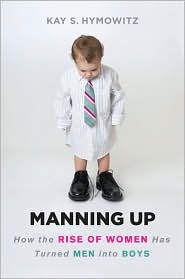Manning Up by Kay Hymowitz is another in the slowly evolving series of books issued by female-staffed but male-run New York publishing houses on the precariousness of American men. They aren’t very good overall, but this one packs quite a surprise: Hymowitz spends a great deal of time covering the design profession.
She’s punchy and zippy and she doesn’t waste a word, but Hymowitz still takes the whole book to make the case that the age-old path of education, marriage, and childbearing has been disrupted for women (which we knew already), but has been shattered for men. The latter point is the value proposition of the book, you might say. But, true to form and underlying bias, read the whole book and you realize it’s actually about women’s accomplishments, to which men’s are compared. (Editors, if any, were too close to the text to realize this, I assume. In point of fact, the book documents the rise of women; it differs from so many competing books in actually giving a shit about men.)
Are gays in there? Just as an indicator of how fabulously tolerant and liberal “men” and “women” are today.
 Nonetheless, Hymowitz works from an analytical point of view I’ve never run into before. Why has the life plan of yore been disrupted for young heterosexualists? In large part because there are now so many career options, few of which you could possibly train for in college or university now or in the past. As she puts it: “Constitutional law may be really hard, but any fool can understand the steps you take to become a lawyer. A lot of today’s careers are more mysterious. How do you become a documentary filmmaker? A grant officer for an international-aid foundation?” (I asked one; he didn’t know either.) “An entrepreneur?”
Nonetheless, Hymowitz works from an analytical point of view I’ve never run into before. Why has the life plan of yore been disrupted for young heterosexualists? In large part because there are now so many career options, few of which you could possibly train for in college or university now or in the past. As she puts it: “Constitutional law may be really hard, but any fool can understand the steps you take to become a lawyer. A lot of today’s careers are more mysterious. How do you become a documentary filmmaker? A grant officer for an international-aid foundation?” (I asked one; he didn’t know either.) “An entrepreneur?”
She could have added: “A designer?” but Hymowitz hardly needs prompting. She’s got pages and pages and pages about designers. Historically,
[t]he class doodler or tinkerer was an outcast who ranked somewhere in the school hierarchy above the tuba player and below the substitute goalie on the hockey team. The design economy has turned outsiders into cool kids with big futures. They can be graphic, industrial, set, or Web designers, or costume, dress, shoe, handbag, children’s-clothes, furniture, wallpaper, tile, or toy designers. They can be strategic, font [!], user-interface, videogame, or infographic designers. They can be creative or art directors, fashion or food stylists, production or lighting artists, or animators.
In the 1960s, we would have said these artists were selling out, but that was before the design economy shattered the boundaries between both art and business and the bohemian and the corporate.
Care for some more?
She keeps right on going from there.
Is there a bonus? There’s a bonus. She keeps the claws sheathed and maintains a tone that would be respectable at any Upper East Side dinner party, but I have never read a more devastating denunciation of Sex and the City.
We’ll talk about the typography sometime later, but I was surprised and delighted by Manning Up. If the D-Crit program made any sense at all, this would be the kind of book it would teach.